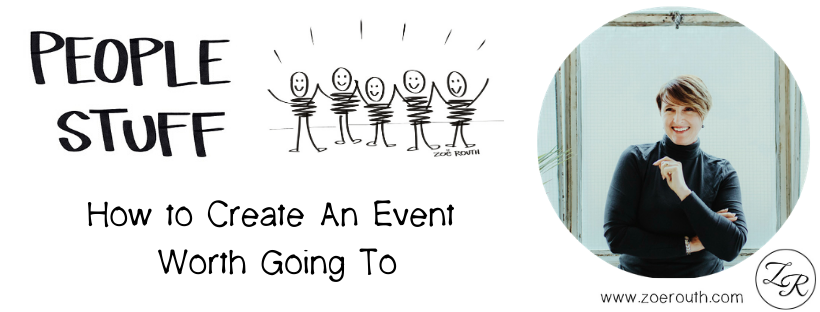How to Create An Event Worth Going To
Since the shut down, the absence of events has either been a blessing or a curse. One thing is for sure, it’s made us rethink the ones we do by default. When we are allowed to gather once more, in small or bigger groups, events will need careful consideration.
by Zoe Routh
If we’ve learned anything through the pandemic, we’ve realised that we need to be more intentional about our gatherings, especially our face to face ones.
For many, the work from home orders have shown us the benefits of these arrangements:
✔️ Less travel
✔️ More comfort
✔️ More convenience
✔️ More productivity (sometimes!)
It’s not true for every situation, but true for many. Enough to consider a blended work arrangement for the future.
It means that getting together in the future, in person, in small or large groups, is going to need to be for a VERY good reason if it’s to get us out of our track pants and slippers.
There are important benefits to face to face gatherings, especially for teams, and they are all biochemical:
Oxytocin: it’s the feel-good neurotransmitter that we get from human touch (a handshake, a hug, a back pat). It also gets released in well-bonded teams, and in moments of connection. These moments are best nurtured in person. We can use all of our subconscious body language sensors to cue intimacy and trust. And when we have physical proximity, our neurochemistry can become synched, especially if those teams have solid systems and structure around interactions to create team safety.
Serotonin: another feel-good neurotransmitter that gets triggered with recognition and elevation of status. When we get recognised by our boss or peers, or when we see others getting recognised, we get a surge of serotonin, and a wonderful feeling of well-being washes over us. Being close to others physically amplifies the sensation.
Dopamine: that’s the little buzz we get from completing a task, getting something done, finding something, recognising a pattern, or solving a problem. When we do this together, the buzz is electric and amplified.
Endorphins: aside from exercise and sex (use your judgment as to the appropriateness of these in the workplace!), we get a load of endorphins when we cry and when we laugh. When this happens collectively, the relief after release creates a sense of connection that is extraordinary.
Cortisol and adrenaline: these are stress hormones designed for quick bursts of energy during times of intense stress or activity. Can trigger survival responses (which is not good for teamwork).
Norepinephrine: similar to cortisol and adrenaline in its effect. It’s the same feeling, whether we see something as threatening or exciting. Pro-tip: reframe an experience as exciting instead of threatening and you will stay in a productive state.
In planning your gatherings then, as CEO, here’s what to consider:
- Every gathering has a purpose.
- Every gathering has a meaning.
- Every gathering has feelings.
We need to cultivate waves of meaning and feelings across each gathering. This is the art of being a neuro-leader!
Here are four types of gathering to master:
Culture Gatherings
These are best for heightened oxytocin and serotonin. Design activities for:
- Celebration
- Community
- Connection
Strategy Gatherings
These are best for norepinephrine and dopamine: building excitement and finding solutions and patterns. Explore:
- Purpose of the team and business.
- Potential of the team’s ability and capacity.
- Possibility for the team and business’s new achievements.
Change Gatherings
These are best for easing the stress hormones of cortisol, adrenaline, and norepinephrine when faced with the unknown. Articulate with others:
- Gap between now and next.
- Map across the gap.
- Message to guide us through.
Productivity Gatherings
These are great for dopamine and norepinephrine: finding solutions, getting tractions and moving forward. Create activities for:
- Problem solving
- Planning
- Marking progress
Gatherings that are just for updates? Seriously, we have better things to do with our time. Unless we’re making a gathering a purposeful, meaningful, and a neurochemically-laden experience, don’t bother.
What gatherings are you planning? How can you make them more powerful with intentional amplification of biochemicals?
***
How to Reset the Team After Shutdown
Perspectives: Is Your Strategic Plan Full of Holes? Here’s How to Fix it Now
How to Make Sense of Normalised Chaos
P.S. And when you’re ready, here are three ways I can help:
1. Grab a free copy of our People Stuff Toolkit
It’s the roadmap to better teams and culture and includes an e-copy of my latest book, Loyalty, as well as checklists and templates.
2. Get equipped at our next event
Meet other adventurous leaders seeking to be, think, and do more. Leadership training and tribe meetings are listedhere.
3. Join me and other renegade pathfinders in AMPLIFIERS to get your deep work done.
AMPLIFIERS is an implementation community for big thinkers. If you’d like to amplify your message, motivation and results, send me an email with AMPLIFIERS in the subject line and let me know a little about your work and what big impact you’re striving for.
— Published on May 25, 2020